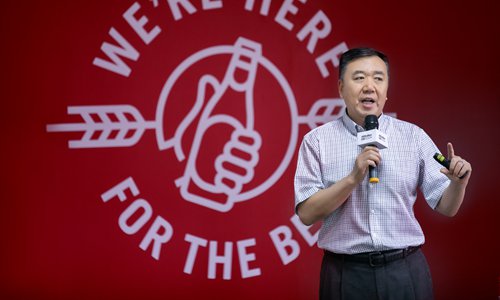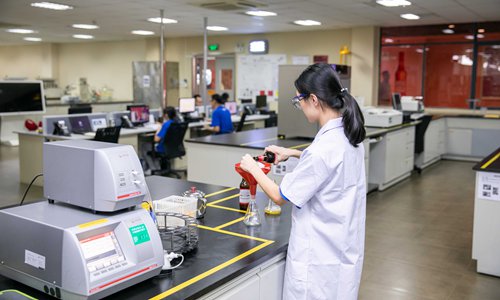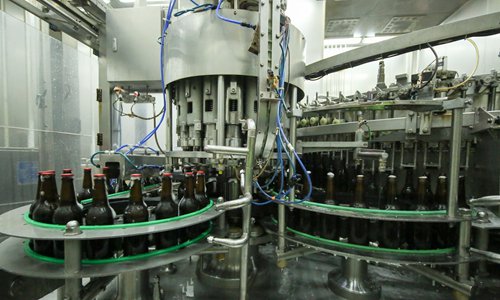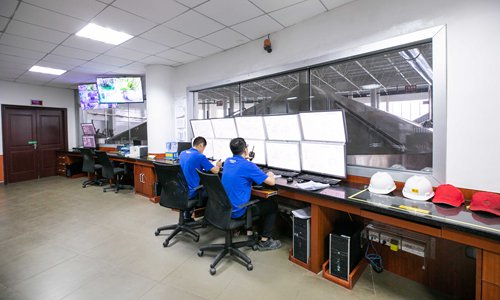
Cheng Yanjun, AB InBev's VP Supply & Logistics, APAC North, said being a multinational company comes with several advantages in brewing top-quality beer.Photo: Courtesy of AB InBev

A Budweiser quality assurance lab professional conducts sample tests on the fully-automatic beer analyzer. The AB InBev Foshan brewery was designed and built with a fully-functioning lab, which is equipped with a wide range of industry-leading equipment. The lab tests more than 6,500 criteria per day to improve the quality assurance standards across all stages of brewing: raw material quality, production process and packaging.Photo: Courtesy of AB InBev
If beer is the medium, then Budweiser is the message. "We're here for the beer," is the global brand's corporate motto.
However, as with any other product of popular culture, the meaning of the message depends on the receivers. Therefore, beer drinking culture in Germany is different from that of the US or China. In the US, Budweiser is marketed as the go-to light beer for the working class, but in China, it is an American premium beer. However, the brewing tradition remains the same.
Anheuser-Busch InBev (AB InBev), the multinational that has the largest share of the global beer market, including the Budweiser brand, operates around 40 factories in China. The largest one brews 20 percent of all Budweiser beer globally - 1.6 million tons per year. It is stationed in Foshan in South China's Guangdong Province. On July 10, the factory opened its doors to let the public in on a few of the secrets behind its reputation as the "king of beers."
Upon entering the factory grounds, the hot and humid Southern Chinese air mixed with a heavy smell of fermented grains. The factory tour started with the brewery's saccharification workshop then proceeded to the packaging workshop and the quality test lab before ending with a taste of freshly brewed ice-cold Budweiser.

Budweiser bottling lines can fill 600 to 800 bottles of beer within a minute. It only takes 0.8 seconds for a bottle of beer to travel from the mouth of the bottling machine to the capper. Photo: Courtesy of AB InBev
Budweiser's aim is not just to brew beer, but good tasting beer that meets a high standard. According to Cheng Yanjun, AB InBev's VP Supply & Logistics, APAC North, beer is deemed high quality when it meets the national standard and consumer preference, and being a multinational company comes with several advantages of scale that help to achieve that high standard.
"First, we can build on our wealth of experience in global manufacturing. Second, we promote active exchange and best practice sharing between our staff. Third, we can build up the level of the technologies applied and also the level of automation," Cheng said.

Budweiser's technical staff monitors the data coming in from the brewery to safeguard product quality.Photo: Courtesy of AB InBev
The factory's new production technology is mainly applied in the packaging stage with bottling lines that can fill 600 to 800 bottles of beer within a minute, meaning that they can bottle and cap at least 10 bottles of beer per second.
But high-tech application also comes in earlier, during the saccharification stage. The company's monitoring computer BRAUMAT checks almost 1,500 indicators in the brewing process, such as temperature and time, and uses computers to automatically control each process to make sure that the quality and taste of each bottle of beer is consistent.
Through technologies like BRAUMAT, Budweiser maintains its global standards whether its beer is being bottled in the US or China. The selection of raw ingredients that meet Budweiser's global standards is also another key factor, and according to the company, its standards are stricter than China's national standards. The water, supplied by the city of Foshan, is processed through the Budweiser water treatment machinery first. The malt is imported from Canada and the hop from the US or Germany.
Another critical aspect of the company's supply chain is transportation. Budweiser's transportation logistics contribute to 5.5 percent of the global carbon emissions, but Budweiser makes an effort to reduce its CO2 emissions both in production and transportation.
"In terms of logistics, we have replaced our vehicles that burn gasoline with those that burn natural gas," Cheng explained.
Food safety and quality assurance is a big concern for Chinese consumers. Budweiser not only tests more than 6,500 criteria per day to assure top brewing quality, but AB InBev has also launched a full traceability system, in which each bottle of Budweiser carries a traceability code. With this tiny code, the brewery can trace the movement of a bottle of beer from malt to the finished product within just four hours. The data extracted by the code covers not only information like production time, warehouse storage position and duration but also the license plate number of vehicles that deliver the malt and their suppliers as well.
Zhang Wujiu, vice dean of China National Research Institute of Food and Fermentation Industries, who was a part of the brewery tour, said consumers should treat market rumors rationally and reach out to relevant authorities for evidence and advice.
In China, Budweiser is the drink of choice for the trendy urban middle class whether they are in a bar or attending a business dinner. Whether one is a blue-or-white collar worker, Budweiser makes sure to be "here for the beer" so that their customers around the world can enjoy the taste and quality they expect from the "king of beers."
